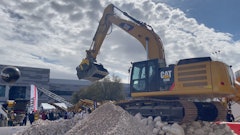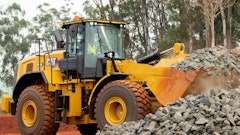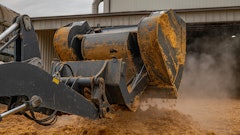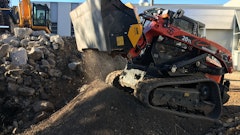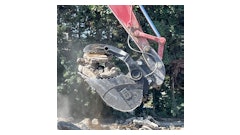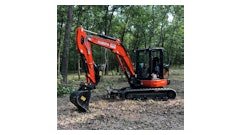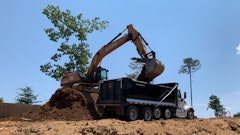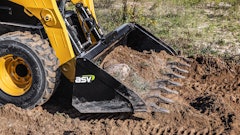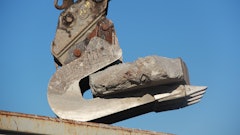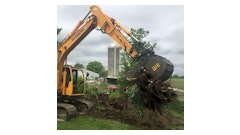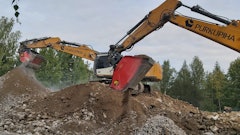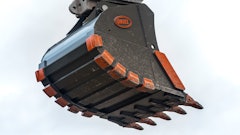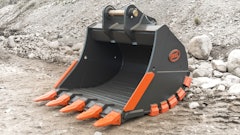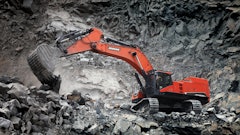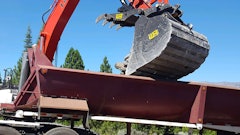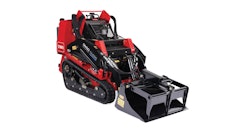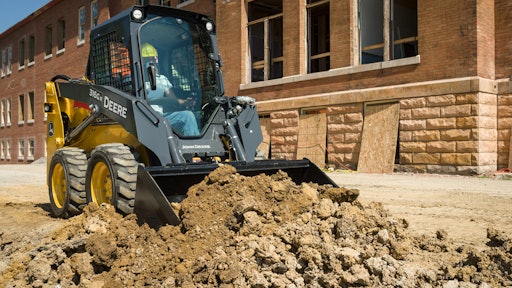
While many contractors simply utilize the general-purpose buckets that tend to come standard on skid-steer and compact track loaders (CTLs), there are many bucket options that can tailor machines to specific applications, making them more efficient and productive. The source of these buckets can either be the machine OEM or will-fit suppliers specializing solely in attachments, including buckets. Given all the choices available, you may either become thoroughly confused, or find a bucket, or possibly two or three, that best accommodate your needs.
To find to most appropriate bucket, you will need to know the following:
- Skid-steer tire or CTL track width
- Bucket width
- Material weight
- Operating capacity
 There are many considerations when selecting a bucket, including loading height.
There are many considerations when selecting a bucket, including loading height.
Buckets tend to fall into four basic categories: general purpose, light material, multipurpose and specialty. Specific terminology for buckets varies between manufacturers, so ask your representative about the characteristics of each one to ensure you’re getting the right fit.
Bucket Width Considerations
In most cases, the bucket should be wider than the tires or tracks of the carrier. If the bucket is not wide enough, you will be operating within the track of the machine, so you will not be operating on a flat plane. Also, if you overfill the bucket, the excess will spill over the edge and the tires or tracks will run over it, which changes the level of the machine. Ideally, the bucket should be about an inch or two wider than the tires or tracks.
If you go too much wider, you can run into problems with machine overload. Keep in mind that wider and larger buckets will also weigh more, which will limit the amount of material you can carry, especially with smaller loaders. Bigger isn’t always better.
Material density and weight
For the bulk of applications, a traditional dirt bucket — a.k.a., construction, industrial or general-purpose bucket, depending on whom you talk to — is likely the best choice. It is by far the most commonly used type. But even here you need to make decisions. Do you need extra strength and durability? How about teeth? What size do you need?
Dirt buckets generally are good choices for digging and moving dirt and rocks. But the material’s density and ground conditions will dictate if you need to upgrade to a heavy-duty dirt bucket. Constructed from a greater thickness or higher grade of steel, this bucket type is designed for harsh applications that need added durability.
Heavy-duty buckets are made for more severe, rugged use such as on a CTL or a larger skid-steer loader with more power, traction and force. Of course, when you add strength to a bucket, you also add weight. This in turn reduces the weight of material you will be able to carry.
For example, while a 66-in. standard dirt bucket may weigh 540 lbs., a 66-in. heavy-duty dirt bucket may weigh about 660 lbs. In many applications, the heavy-duty bucket may not be the best choice since the bucket weighs an additional 120 lbs., which reduces the available lift capacity of the loader.
The limiting factor in buying any bucket is the weight and density of the materials you’re lifting. Look for the cubic foot rating on the bucket to make sure you don’t overload the machine capacity, which can stress the engine and drivetrain. Depending on the carrier, overloading may also eliminate your ability to roll back the bucket. Even worse, it can compromise safety. Carrying more load than intended for a given size loader can cause its back end to lift off the ground.
When it comes to capacity, it may be tempting to opt for more than what is actually needed in an attempt to get work done faster. But that may hurt the performance of the machine. Sometimes, it’s a balance between capacity and cycle times. It may be possible to do more work with a smaller bucket because you aren’t constantly overloading your machine.
Capacity vs. breakout force
Bucket capacity is the maximum volume a bucket can hold, typically measured in cubic feet. There are two types of bucket capacities: struck capacity and heaped capacity. Struck capacity is the volume the bucket holds when filled level with the top of the bucket. Heaped is the volume the bucket holds when it’s slightly above the top of the bucket.
For weight calculations, use the heaped capacity for safety. You need to know this number and the density of the material to be handled to correctly match the bucket to the machine’s operating capacity. Multiply the material density by the bucket capacity to get the weight of the material being lifted. Be sure to include the weight of the bucket.
 Multi-purpose buckets increase versatility and minimize the need to transport other attachments to the jobsite. The tradeoff is it does come with reduced capacity and increased complexity.
Multi-purpose buckets increase versatility and minimize the need to transport other attachments to the jobsite. The tradeoff is it does come with reduced capacity and increased complexity.
When capacity is an issue, you may want to consider a low-profile dirt bucket. These buckets have a longer lip, which in some cases offers more capacity. They also have a lower back, which enhances visibility.
Low-profile buckets have become increasingly common. In addition to slightly more capacity, the increased visibility to the cutting edge allows the operator to see the edge when working close to curbs, gutters and buildings.
While a low-profile bucket may enhance capacity, smaller buckets with a shorter lip and shorter bottom offer more breakout force than larger buckets with longer lips and deeper bottoms. This is due to simple geometry. A shorter distance lets you put more force on the bucket to break through the material.
Select proper GET
Ground Engaging Tools (GET), such as weld-on or bolt-on teeth and bolt-on edges, can affect breakout force. If the material to be moved is highly compacted with rocks, a bucket with teeth and a shorter floor length will increase the breakout force. Teeth can also be beneficial in summer months when it’s dry because they can break through the hardpan.
If teeth are not needed (or wanted), a bolt-on edge can save wear and tear on the bucket edge. The surface the bucket will be used on determines if a bolt-on edge is necessary.
The bolt-on edge is the leading cutting edge on the bucket. It can be replaced if worn out, and will not affect the edge welded in the bucket.
The corrosive nature of the material the bucket will encounter is another consideration. Thicker steel will mean longer bucket life in a corrosive environment.
Beyond dirt
While dirt buckets are by far the most popular choice for compact loaders, there are situations that dictate a different option.
If the material to be moved is considered light material, you may want to consider a bucket with a higher capacity rating to move a higher volume of material in a shorter time frame. Light material buckets are deep with a high back to carry larger volumes of lighter material such as mulch, wood chips, sawdust, bark, etc. In some cases, they do double duty as snow buckets, although dedicated snow buckets are available from some suppliers. Utility buckets can also be grouped into this category.
These buckets are not intended for digging but rather for moving material. They typically have more capacity than a dirt bucket, but they don’t have the strength. They are for loose materials or for backfilling around foundations.
 Caterpillar offers skeleton buckets for use with skid-steer, multi-terrain, compact track and compact wheel loaders that allow operators to quickly separate rock and debris from soil.Caterpillar
Caterpillar offers skeleton buckets for use with skid-steer, multi-terrain, compact track and compact wheel loaders that allow operators to quickly separate rock and debris from soil.Caterpillar
Skeleton and brush grapple buckets are essentially sifting buckets. They are a good choice for demolition or any task requiring you to separate dirt from the base material, since they let dirt pass through. Tasks could include separating out stone, brush or any other material that is large enough to not fall through the “cracks.” These buckets are also available with a grapple for handling and ripping out brush, small trees and shrubs.
Scrap grapple buckets are essentially buckets with open sides — they have a bottom lip and back with sides cut out, plus a pair of grapples. For construction applications, they are often used to handle brush. They may also be needed in a demolition-type application with grapples mounted to the top of the bucket.
Multipurpose buckets
Multipurpose or 4-in-1 buckets have gained popularity. These buckets can perform multiple functions because the bottom and sides can separate from the back. Operators can dig, load, carry and dump material as with a construction bucket, plus grip debris like a grapple, or grade and level dirt. Serrated grapple edges are good for moving logs, beams, concrete chunks or other bulky materials.
When closed, multipurpose buckets operate like a standard bucket, but with an added advantage for dumping at maximum height. You can roll the bucket out like you would any other bucket; dirt or other material will spill over the cutting edge, which works 99% of the time. But if you’re trying to reach into a dump truck that’s at the limit of the lifting height capacity of your machine, you can’t roll out a bucket enough to dump it because you will hit the sides of the truck. With a multipurpose bucket, you can simply open up the bottom of the bucket and spill out the material.
 The Case 4-in-one bucket allows the operator to experience the benefits of four attachments in on. It functions as a bucket, clam, dozer and scraper.Case Construction Equipment
The Case 4-in-one bucket allows the operator to experience the benefits of four attachments in on. It functions as a bucket, clam, dozer and scraper.Case Construction Equipment
The main advantage of a multipurpose bucket vs. a general-purpose bucket is versatility. When a skid-steer or CTL is equipped with a multipurpose bucket, it doesn’t have to be changed as often and it reduces the need to haul additional attachments to the jobsite. This can result in time and space savings.
While these buckets definitely offer some advantages, there are drawbacks to consider. Because of the mechanics required to open and close the bucket, you do lose some volume. Cutting edges and hydraulics also add to the weight, which decreases the available capacity.
Multipurpose buckets are a more complex attachment, as well. The bucket cylinders are exposed and, by the nature of the bucket’s function, could be damaged. You must make sure the hydraulic cylinders are set in and protected from dirt and built-up debris. Make sure the cylinders are shielded. Hose routing should preferably be run internally through the bucket as much as possible to avoid being snagged and damaged.
In addition, multipurpose buckets can cost up to three times as much, or more, compared to similar-sized dirt buckets. Yet, many contractors who have made the investment don’t go back to a standard bucket. They find they need to leave the seat much less frequently because the machine can now pick up things that the operator used to have to get out of the machine to do.
Specialty buckets have several different applications, and each have pros and cons depending on the job. It is very important that the right bucket is used for the given application for both the machine and bucket to be cost effective.
Oftentimes, contractors will find that there is more than one right bucket for their typical applications. Universal quick-attach systems on many of today’s skid steers and CTLs allow quick changes in seconds. In many cases, the buckets can be changed without the operator leaving the cab. This makes the case even stronger for selecting the most appropriate bucket for the job at hand.
Information for this article was supplied by Bobcat, Caterpillar, Gehl, EDGE, JCB, John Deere, Stanley Infrastructure’s Paladin brand and Takeuchi.




